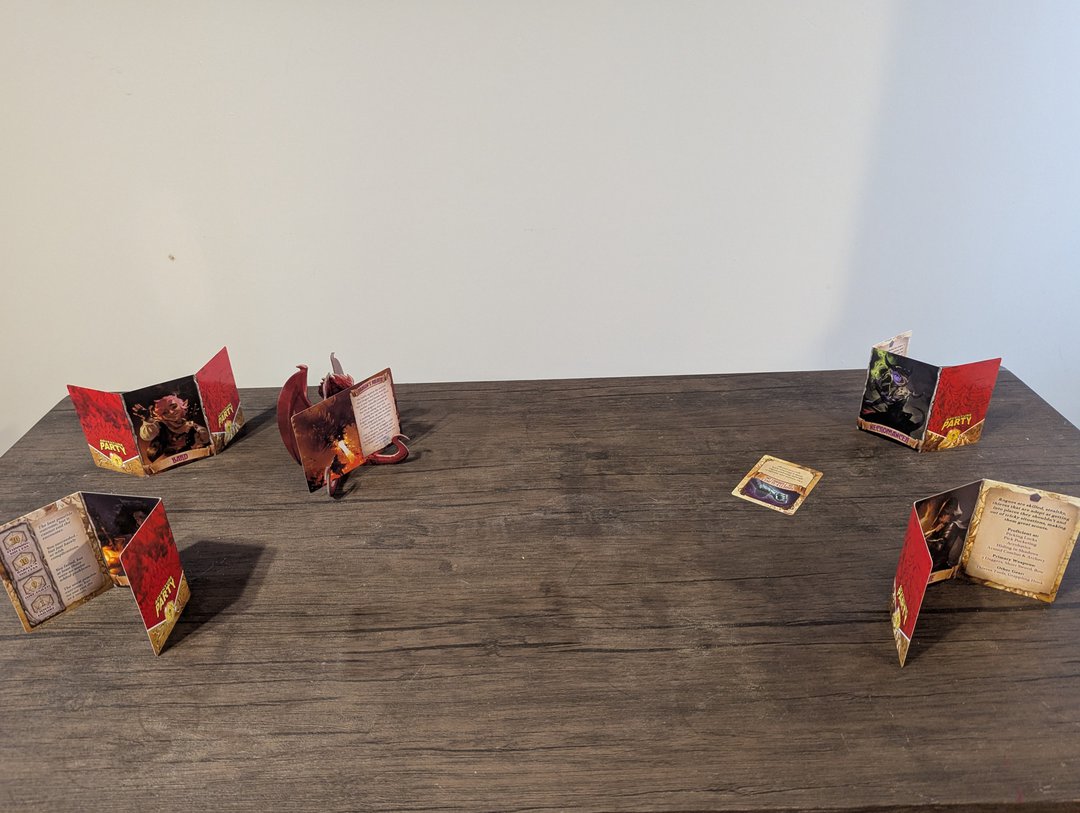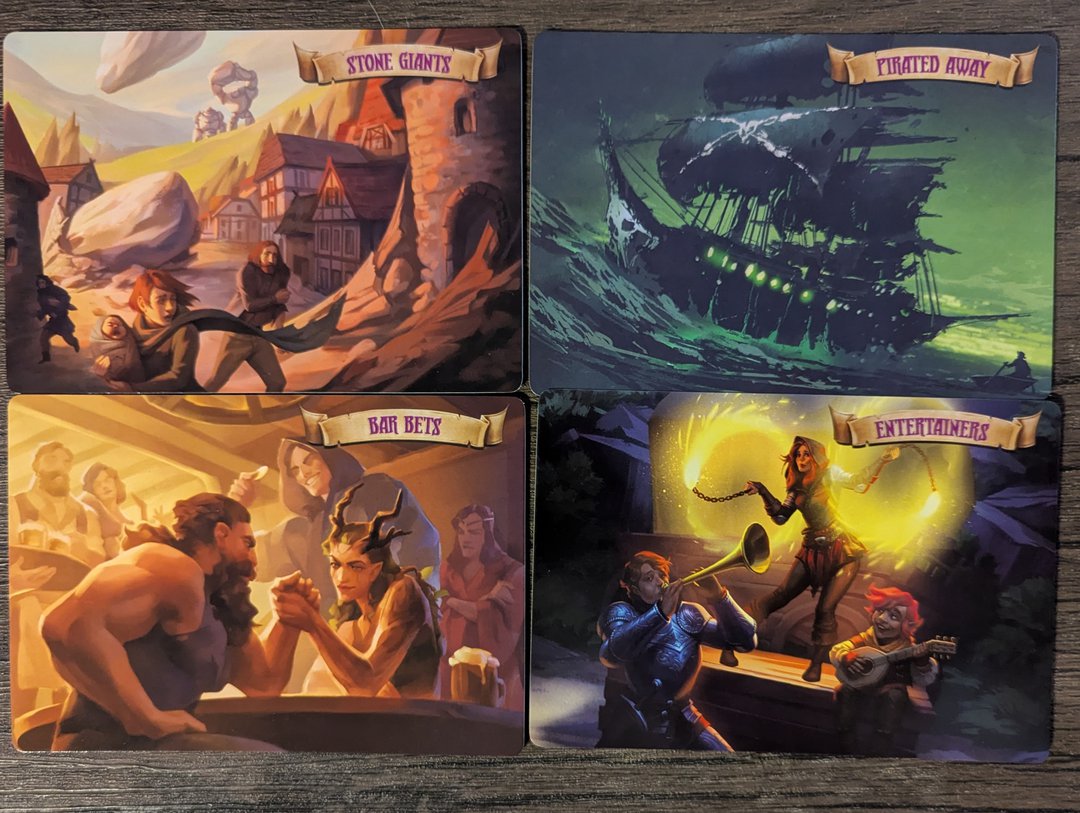Ever want to play Dungeons and Dragons, but without all of the set up, the prep time, and the scheduling? It's a tough ask, but there are solutions if you are willing to experiment. Smirk and Dagger's attempt is Adventure Party, which takes the classic high fantasy TTRPG experience and mixes in elements of board games and Mad Libs. The result is a collaborative storytelling game for 3-8 players, featuring a splash of social deduction and a lot of laughs.
It works better than you would expect; it lets you and your friends tell a dramatic story, roll some dice, and have to improvise on the fly. The real question that needs to be answered is whether or not this hybrid of board game and role play fits the style of you and your friends.

The characters cover a wide range of TTRPG classes and fantasy tropes. Since the characters have no stats or abilities however, there’s nothing stopping you from homebrewing your own, even bringing in your own characters from past games.
How to Play: Roll a Die and Make Stuff Up
Much like the game as a whole, Adventure Party’s setup is simple and straightforward. The group chooses anywhere from 1-3 Adventure scenarios to play through, depending on how long you want your campaign to be. Each player chooses a character, which purely for roleplaying purposes, since they’re all functionally identical in terms of rules, and then the party goes off on a series of adventures.
Each player then gets two random item cards. The items often won’t match your character’s theme, like the Berserker getting a magic wand, or the Wizard ending up with a strength-enhancing belt. Don’t worry: any character can use any item, and the more mismatched it is, the funnier your story will be. Like I said, this is more about your imagination and coming up with an improv story than an epic tale of combat and tactical plays.
You’ll also get one Valor token, which you can use to reroll a die and keep whichever result you prefer. In my experience though, Valor tokens don't get spent very often. low rolls are just as much fun as high rolls, and usually much funnier.
Play begins when the GM (Guess Master) reads the first Adventure card aloud, and the player to their left takes the first action. That player chooses one of their two items and describes how they intend to use it to advance the story. They roll a d20, then describe what actually happens based on the result. For example, one of the Adventures is a battle against a fire-breathing dragon. The first player might say that their Fighter takes the Lute of Lightning item and, since he has no idea how to play a lute, tries to smash it over the dragon's head. The player then rolls to see how well it works, and uses their imagination to describe the outcome. A few potential results could be
- Roll a 1 (total failure): As the lute hits the dragon, a lightning bolt shoots out of it going the wrong way and blasts the Fighter across the room.
- Roll a 4 (failure): The lute splinters harmlessly against the dragon’s scales.
- Roll a 12 (success): The Fighter lands a solid blow, the dragon is noticeably hurt.
- Roll a 20 (stunning success): The lute hits in just the right way to play a magical chord that blasts the dragon with lightning, injuring and briefly paralyzing it.
After the player describes their action, the Guess Master may ask one question to clarify exactly what happened, or how the result compared to what they were trying to accomplish. The GM then has to guess what the player rolled. The party earns XP, which are really just victory points, based on how close the GM’s guess is.

Note that the party's score isn't based on how well the characters do, just on how close the GM's guesses are. You could roll nothing but 1s and still finish the campaign!
Everyone else also gets to guess what the player rolled, which is a great detail that addresses the classic TTRPG problem where players spend most of their time just waiting for their turn. However, only the Guess Master can earn XP, with the other players instead earning Personal Glory. After the guessing is done, play moves to the left: the next person in line becomes the new player, and the one who just rolled becomes the new GM. Repeat the whole process until everyone has had a turn; as a heads up, this does mean that with more players, the games do take longer. The last player's action should wrap up the scenario somehow, whether that’s with an epic victory or the party slinking away in defeat.
If there’s another Adventure to play through, the current Guess Master reads a short Transition card leading into the new scenario. After that, everyone discards their remaining item and draws two new ones, and play continues.
 Adventure Party
Adventure Party
Designer: David Smith, Travis Winstead
Publisher: Smirk & Dagger Games
Number of Players: 3-8
Play Time: 30-60 minutes
Price: $39.99
Review Copy: Review Copy Recieved By Publisher at PAX Unplugged
At the end of the game, the party as a whole receives a rank based on how much XP they earned throughout the campaign. The player with the most Personal Glory calculates the rank - which ranges from Legendary to Embarrassing - and announces it to the group. That person then brings the story to a close by describing how people will remember the party; as great heroes who saved the world, as total screw ups who burned down the city they were trying to protect, or whatever else seems appropriate.
One final thought about the gameplay: Normally, a cooperative game means you all win or lose together. What’s really interesting about Adventure Party is that there is no winning or losing, there’s only the story you all tell together. A rank of Embarrassing isn’t a loss, it’s just a funny ending to that story. If it hasn't been made obvious already, this is a game meant for fun and relaxation, going great while having some drinks and food around a table. If you are a bunch of theatre kids, this game was made for you. It is amazing how over the course of two or three scenarios, you can end up having everyone coming up with a big backstory for these throwaway characters, giving a sense of real adventure even if a game lasts just an hour.

Scenarios range from monster encounters and high-seas adventures to, literally, "Hold my beer!"
My Suggestion: Join The Party!
Adventure Party is a great game for anyone who loves TTRPGs, but doesn't take them (or themselves) too seriously; it's a party game with great theming and enough rules to add some depth and personality. It's heavy on roleplaying and light on tactics, which makes it a great way for people who've mostly experienced TTRPGs as tactical wargames to explore a different side of them. It's also great for people who are into improv or want to give improv a try. Or, heck, for literally any group of friends alongside a few drinks. It's not a replacement for tabletop games, but sort of an odd offshoot which fills its own place in a board game library.
$40 is a bit on the pricey side for a party game, but it’s totally reasonable for what you get with Adventure Party, especially considering the gorgeous art on every card. The game also comes with a bag of eight d20s, just in case someone who hasn’t played D&D or Pathfinder gets their hands on it. Again, this is a game that has a very specific mood - we've had luck playing it at the end of a board game night where people want to keep hanging out, but don't have the energy to invest in a full on ttrpg session. On other nights, if players want games with more hard and fast rules, we pass on this for some other time.
If you enjoy whimsy and a chance to tell tall tales with friends, you are in the right place, and you can get some of the same magic you sometimes achieve during a D&D campaign in an hour or less.